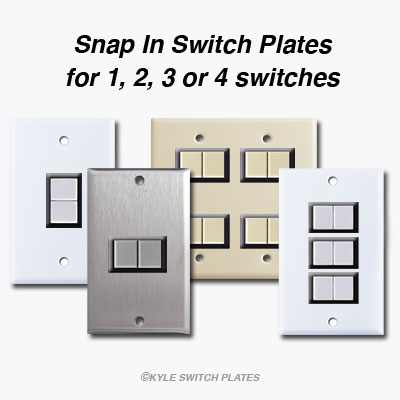Produced exclusively by Kyle Switch Plates, this updated newer style snap-in series of GE low voltage switchplates helps to save you time and money when replacing your existing low volt wiring components. Compatible with General Electric's current line of push button style devices, these wall covers offer simple installation as switches mount directly into the front of the wall plate - no mounting brackets needed. Perfect for homeowners who need to upgrade their remote control wiring system on a limited budget.

Exclusive GE snap-in series low voltage switch plates include sizes for 1 Vertical Light Switch, 1 Horizontal Light Switch, 2 Light Switches, 3 Light Switches and double gang switch plates for 4 Light Switches (two gang dual switches) or 6 Light Switches (two gang triple switches). Low voltage replacement electrical devices and power supplies include General Electric Mechanical Relays and Replacement GE RT1 Transformers.

Select low volt snap-in switchplates when you need to replace both switches and wall covers in your low voltage wiring system. Compatible with newer GE push button type devices, these switch plates have device openings of 1.278" x .76" and are available with one, two, three, four or six switch holes. Openings on three-switch wall covers are .906" apart and 1.812" apart on two device plates. Screw holes measure 3.281" center to center.

Snap-in switch covers do not require a metal strap or yoke to mount devices. Specially designed to work with low voltage devices, these unique wall covers allow you to mount low voltage light switches directly into the front of the face plate, eliminating the need for mounting brackets. Don't have an electrical box to mount your switch cover? Screw holes are spaced accordingly so you can install snap-in switch covers directly into a wall or plaster.

In the photo at left, we have installed both an Old General Electric Switch and a New GE Switch in the original style mounting straps or yokes. While the current GE devices can, with a bit of effort, be jammed into the old straps, they are thicker (protrude more) than the old switches. As a result the switch plate will not mount flush with the wall and will stick out about an 1/8" revealing your cut plaster. If you have any doubts about how these will work, then use the #2 Snap-In style plates with the new GE Switches.

GE's current line of 2-button SPDT (single-pole, double-throw) low voltage switches includes standard unlighted, locator, raise-lower and pilot light switch styles. Unlike the older GE RFS rocker switch series, these devices offer convenient trouble-free wiring with 5 quick disconnect terminals for unlighted switches and 6 terminals for lighted devices.

The GE RMP235 selector switch plate for eight low voltage devices is the updated replacement part for vintage GE RMS-4A 12 button selector panels as well as the compact GE RMS-2A 9 switch selector with knob. Compatible for use with GE pushbutton light switches, this master panel allows you to conveniently gang 8 switches and control multiple circuits from one location.

If you need to replace 9 or more light switches, choose the 12 switch wall plate cover. This fits a 3 gang opening but has no master controller. If you don't have a full twelve switches, dummy switches are also available for filling blank openings.

Today, Bryant Electric is owned by Hubbell Inc. and no longer manufactures its original line of low voltage devices and switchplate covers. For those needing replacement hardware for Bryant remote control wiring systems, we recommend General Electric Low Voltage Switches & Wall Plates which can be interchanged and are compatible with original Bryant wiring set-ups.

For a modern touch, consider upgrading dated GE or Bryant low volt devices to Touch-Plate low voltage momentary switches. Touch-Plate switches work from two wires, however, so you will need to replace every 1 GE or Bryant switch with 2 Touch-Plate buttons to be able to turn a light on and off. Click Compatibility of Low Voltage Systems for more details.
Q. Is a low voltage system grounded?
A. The relays are grounded, but the switches are not.